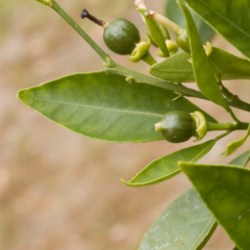Gardening is a hobby that is dear to many people. Everything is done accordingly so that the plant will not suffer after it has been planted. It will only make you frustrated to see your plants in your backyard or garden die just after few days after being planted. It may happen to other people, but you can prevent it from happening to you. Dwarf navel orange trees has the same benefits of a regular orange tree, the only difference is that the dwarf navel orange fruits are more accessible as they are shorter in height. Insects are normally seen on a naval orange tree. Although these bugs may damage some of your dwarf naval orange trees, home gardeners can ignore them because they never threaten the tree over its lifetime, according to Texas A&M University reports. Here is some of the information of insects that you will occasionally see on your naval orange tree.
- Citrus leafminer is a small moth that measures only 2mm and has a silver-white appearance. The moths come out in the early evening until the early morning. They will leave dark trails on the surface of the tree’s leaves. The bore tunnels through the leaves are caused by the leafminer’s larvae. Leafminers only make a problem on citrus trees that are younger than 4 years because it is during this stage that they may slow the growth of the tree. According to the University of California, any standard insecticide made from imidacloprid and methoxyfenozide can be used to prevent these leafminer.
- Purdue University reports that Citrus rust mites are one of the most common insects that you will see infesting in your orange trees. They are tiny, just about 0.15mm or less and have the color of rust-red. If there are many infestations of rust mites, some of the smaller fruits and leaves will drop, but that will only happen in extreme cases.
- All citrus plants will be more prone to mite infestation during the periods of extended drought.
- Scales such as the greedy and the California red scale are sometimes seen on navel oranges. Just like their name, they look like a scale-like growths and stay on the young stems of the orange naval tree. Often, they were accompanied by the ants, which collect the honeydew from the insects after they sucking on the tree’s sap.
- Natural predators for the scale such as the lady beetles and the lacewings can be used to control the scale’s population. You could also use chemical controls, which are based from horticultural oils and petroleum.
- Your dwarf orange naval tree will likely have whiteflies infestation if the tree has a dusting of white powder. This can be seen by checking under the leaves where the tiny white flies gathered. They are commonly seen on the younger leaves on the tree by attaching themselves to the tree and sucking the tree’s sap out.
- Spraying the citrus tree’s foliage with blasts of water everyday will help to eliminate the whiteflies infestation.
Additional Reading:
Growing Citrus: The Essential Gardener’s Guide
The Backyard Orchardist: A Complete Guide to Growing Fruit Trees in the Home Garden
Image Credit:


